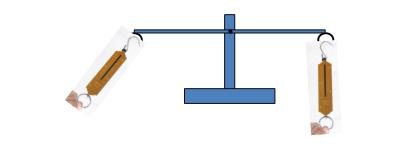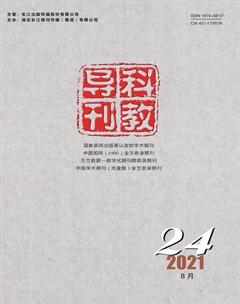表述杠杆的平衡条件要严谨
张平柯
科学教学要高度关注学生的前概念。如果学生的前概念和所要学习的科学概念比较接近,那么学生对该科学概念的理解一般比较容易,构建的概念也比较牢固;相反,如果学生的前概念与要学习的科学观念冲突明显,要让学生接受该科学概念就需要付出艱苦的努力,要让所构建的科学概念在学生头脑中“固化”更不容易。同样,如果学生在学习科学概念的过程中形成了错误的概念,对他们后续的科学学习将造成很大的障碍。
在学习“杠杆的科学”内容时,教师往往利用杠杆尺进行研究,并要求学生实验后填写表格(见下表)。

在这个表格中有2个关键数据,分别是“阻力点到支点的距离”和“用力点到支点的距离”。学生在完成实验后,通过分析记录表中的数据,一般都能“正确地”回答教师提出的问题:在阻力点到支点的距离小于用力点到支点的距离时杠杆省力,在阻力点到支点的距离大于用力点到支点的距离时杠杆费力,在阻力点到支点的距离等于用力点到支点的距离时杠杆既不省力也不费力。
学生通过实验所建构的这一概念,很容易形成牢固的记忆,然而,这一概念的建立对中学学习杠杆的平衡条件却会造成一定的负面影响。
我们知道,杠杆的平衡条件是“动力乘动力臂=阻力乘阻力臂”,而动力臂是动力作用线到支点的距离,阻力臂是阻力作用线到支点的距离。事实上,中学生在学习这部分知识时,很容易出现的错误是把力的作用线到支点的距离弄成力的作用点到支点的距离。
很明显,表格中恰恰就是用力的作用点到支点的距离取代了力的作用线到支点的距离。强调“用力点”和“阻力点”到支点的距离,并由此总结出在什么情况下杠杆省力、费力的结论,一旦在学生的头脑中形成牢固的概念,在中学阶段要实现概念的转化就很困难,从而影响中学的学习。
引入“力臂=力作用线到支点的距离”的概念对小学五六年级学生并不合适,但教师完全可以在学生总结实验结果并回答相关问题后,提醒他们注意这些结论的成立是需要满足一定条件的,并不是在任何情况下都成立。
为了强化这一认识,可增加如下图的演示实验。当学生观察到杠杆平衡时,左右两个弹簧秤读数的明显差异,他们会深刻地认识到,通过在杠杆尺两端挂钩码得出的“在阻力点到支点的距离等于用力点到支点的距离时杠杆既不省力也不费力”的结论是有条件限制的,他们自然还会想到“在阻力点到支点的距离小于用力点到支点的距离时杠杆省力,在阻力点到支点的距离大于用力点到支点的距离时杠杆费力”的结论也是要满足一定条件的。这样不仅不会对中学的学习造成负面影响,还能为中学学习力臂的概念留下一个伏笔。

The Balance Conditions of Leverage should be Rigorous
ZHANG Pingke
中图分类号:G424文献标识码:ADOI:10.16400/j.cnki.kjdk.2021.24.002
ZHANG Pingke
Professor of Physics, Hunan First Normal University
Distinguished Professor of Changsha Normal University
Executive vice President of Hunan Youth Science and Technology Education Association
Science teaching should pay close attention to students’ pre concepts. If students’ pre concept is close to the scientific concept they want to learn, stu? dents generally understand the scientific concept easi? ly and build a solid concept; On the contrary, if the conflict between students’ pre concept and the scien? tific concept to be studied is obvious, it needs to make arduous efforts to make students accept the sci? entific concept, and it is not easy to "solidify" the constructed scientific concept in students’ minds. Sim? ilarly, if students form wrong concepts in the process of learning scientific concepts, it will cause great ob? stacles to their subsequent scientific learning.
Whenlearningthecontent of "lever science", teachers often use lever ruler for research, and re? quire students to fill in the form after the experiment(see the table below).
There are two key data in this table, namely"distance from resistance point to fulcrum" and "dis? tance from force point to fulcrum". After completing the experiment, students can generally "correctly" an? swer the questions raised by teachers by analyzing the data in the record table: when the distance from the resistance point to the fulcrum is less than the distance from the force point to the fulcrum, the le? ver is labor-saving, and when the distance from the resistance point to the fulcrum is greater than the distance from the force point to the fulcrum, the le? ver is labor-saving, When the distance from the resis? tance point to the fulcrum is equal to the distance from the force point to the fulcrum, the lever is nei? ther labor-saving nor laborious.

The concept constructed by students through ex? periments is easy to form a solid memory. However, the establishment of this concept will have a certain negative impact on the balance conditions of learning leverage in middle school.
We know that the balance condition of the lever is "power multiplied by boom = resistance multiplied by resistance arm", and the power arm is the dis? tance from the power action line to the fulcrum, and the resistance arm is the distance from the resistance actionlinetothefulcrum.Infact,whenmiddle school students learn this part of knowledge, it is easy to make the mistake of changing the distance from the action line of force to the fulcrum into the distance from the action point of force to the fulcrum.
Obviously, in the table, it is precisely the dis? tance from the action point of force to the fulcrum that replaces the distance fromthe action line of force to the fulcrum. Emphasize the distance from the "force point" and "resistance point" to the ful? crum, and summarize the conclusion that the lever is labor-saving and laborious under what circumstances. Onceasolidconceptisformedinthestudents’ mind, it is difficult to realize the transformation of the concept in the middle school stage, which affects the learning of the middle school.
The introduction of the concept of "force arm = distance from the force action line to the fulcrum" is not suitable for students in Grade 5 and 6 of prima? ryschool,butteacherscanremindstudentsthat these conclusions need to meet certain conditions af? ter students summarize the experimental results and answer relevant questions.
Inordertostrengthenthisunderstanding,the demonstration experiment shown in the figure below can be added. When students observe the obvious dif? ference between the readings of the left and right spring scales when the lever is balanced, they will deeply realize that the conclusion that "when the dis? tancefromtheresistancepointtothefulcrumis equal to the distance from the force point to the ful? crum", which is reached through the hook code at both ends of the lever ruler, the lever is neither la? bor-saving nor labor-saving ", is conditionally limit? ed, they will naturally think of the conclusion that"the lever is labor-saving whenthe distance from the resistance point to the fulcrum is less than the distance from the force point to the fulcrum, and the lever is labor-saving when the distance from the re? sistance point to the fulcrum is greater than the dis? tance from the force point to the fulcrum". This will not only have a negative impact on middle school learning, but also leave a foreshadowing for the con? cept of learning arm in middle school.

When the distance from the action point of force to the fulcrum is equal, the reading of spring scale is signifi? cantly different.

